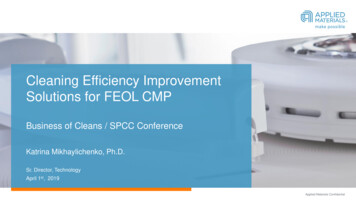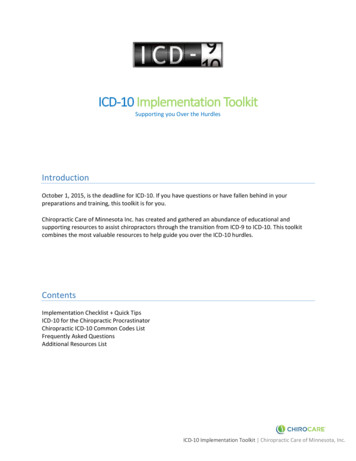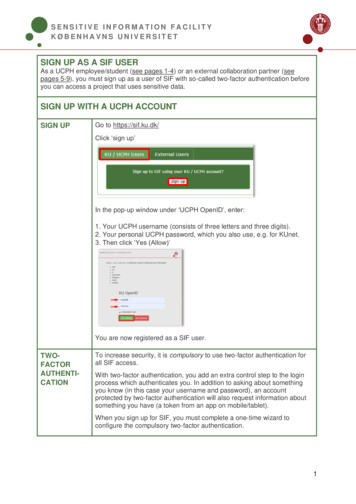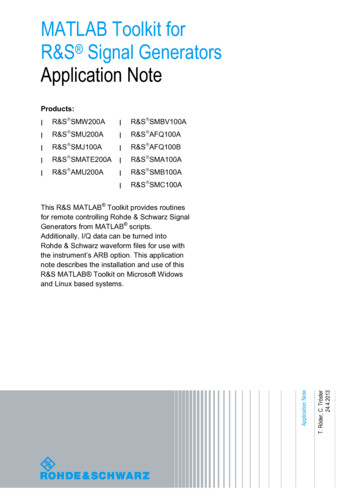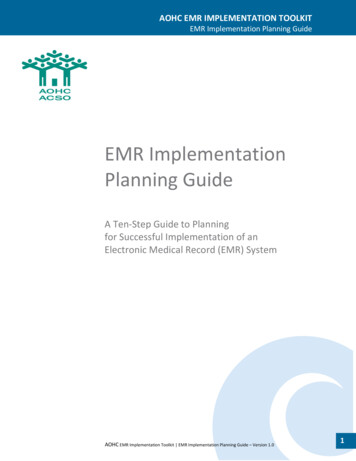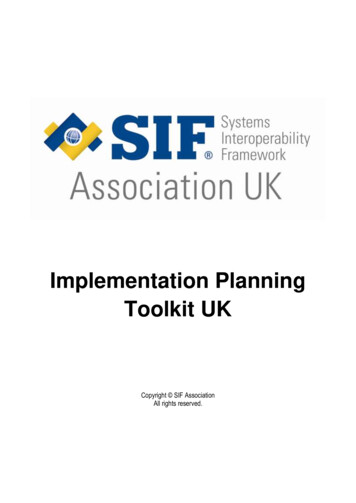
Transcription
Implementation PlanningToolkit UKCopyright SIF AssociationAll rights reserved.
ForewordThis series of resources is not the complete answer to the task of implementing SIF within your organisation. It ishowever, a collection of the best available information at the time of writing.The characteristics of the SIF community are:-neutral environment,-community approach, and-contribution and transparencyThe Implementation Working Group relies on the community approach and the contribution of its members. The aim ofthis is to provide valuable resource to aid colleagues in implementation and the planning process for the adoption ofSIF.These resources should be considered as living documents that will grow in effectiveness due to relevant contributionfrom adopters who have gone through the challenges of implementation.On behalf of the current and future members of the community, we ask that if your hard won experience and knowledgeare going to make the progress of other adopters less arduous, that you do not remain silent but you share your veryrelevant experience. Please email your comments to uk@sifassociation.org.Thank youImplementation Working GroupSIF Association UKVersion 1.1Page 2 SIF Association
SIF Association UKImplementation Planning ToolkitIntroductionSome people make integrating technology sound easy, but others recognise that acquiring the best technology can bevery complicated. If you believe that it is important to make good decisions about selecting, acquiring, implementing,and managing data integration this Toolkit is for you.The purpose of this Toolkit is to provide school, local authority and Regional Broadband Consortia (RBC’s) personnelwith the necessary information and resources to successfully integrate management information systems using the SIFData Standards and SIF Certified software. It is designed to make it easier for people in educational settings to planand make the best possible decisions as they implement the SIF Standards.One of the keys to any integration project is in viewing all of the components as part of a system. The underlying themeof this document is that schools, local authorities and RBC’s interested in implementing SIF Certified software shouldsee this as an opportunity to begin creating an Enterprise Information Management System (EIMS) for theirorganisation. To assist with that task, this Toolkit will walk you through the planning process from conception-of-need tothe deployment of the technology based on the premise of that systemic approach, and a recognition that the integrationwill evolve over time. Within the Toolkit you will find the steps you should take to identify your data integration needs,consider your options, acquire the technology, and implement the SIF Solution that will serve you today and provide afoundation for the future.There are seven major phases that a school, college, LA and/or RBC will need to engage in to achieve the firstsuccessful implementation. You may not need help with all of them, but to make this planning process simple andrelevant, this guide has been developed in the context of a typical project that might be undertaken by a local authority.What is Presented in This Toolkit?The focus of this document is primarily about integrating SIF Certified software that is used to meet administrative andinstructional needs in the context of establishing an Enterprise Information Management System. It should be clearlyunderstood that the technical standards and relevant products will mature over time. Hopefully you will find the in the setof generic questions presented, many that will help you with your decision making process both now and in the future.These are common-sense, experience-based ideas, rather than approaches tied to specific situations or products.These ideas are based upon experience implementing integration technology within schools, local authorities andRBC’s across the country.This Toolkit contains information about project planning, data management, computer hardware, software, andnetworking, as well as budgetary and human resource concerns. This information relates to the use of integrationtechnology as a tool for: Managing information management activities related to instruction. Improving decision making by providing information that is timely, accurate, and comparable. Automating and streamlining day-to-day operations.This Toolkit was designed to provide educators with a process for getting the best possible technology solution for yourschool and/or local authority. Within the kit, you will find a series of steps that you should take to:Version 1.1 Identify your data and systems integration needs Thoughtfully consider your options Acquire the appropriate technology,Page 3 SIF Association
Implement a solution that will serve you today Provide a foundation for the future.This kit covers a variety of issues you are likely to encounter during the process. You may not experience all of them,but you should be aware of them so that you can ensure that the solution you choose will reflect your organisation'sneeds and the context in which your school, local authority or RBC works.Who Should Use This Toolkit?This Toolkit was developed for people in one of three roles: Persons who will be providing executive leadership to the data integration initiative; Persons who have been given the responsibility to manage the data integration in an educationorganisation; Persons who will be responsible for data integrity within any applications which will be part of theimplementation.The individuals who might fill these roles include principals, business managers, information technology staff,technology coordinators, school administrators, food service staff, librarians, integrators, consultants and others. Theymay be the ones with final decision making authority over what will be done, or they may make recommendations to theultimate decision maker.If you perform one of the roles mentioned above, this kit will help you answer real-world questions about how - and hownot - to go about the process of putting SIF-enabled technology into place. The expectation is that as you go through theprocess outlined in the kit, you will find a number of useful ideas that can be applied to your specific situation.The Toolkit is not designed to cover the range of technical issues one might encounter during a SIF Implementation.The document is focused on those non-technical issues, yet it includes terminology and concepts basic tounderstanding this technology. Definitions are provided throughout and can also be found in the glossary.The guidelines provided in this Toolkit are expected to be most useful to persons in schools, local authorities or RBC’s.The examples were obtained from different types of education organisations who have actually engaged in SIFImplementations.Version 1.1Page 4 SIF Association
Table of ContentsForeword . 2SIF Association UK . 3Implementation Planning Toolkit . 3Introduction. 3What is Presented in This Toolkit? . 3Who Should Use This Toolkit? . 4Table of Contents . 5How SIF Works . 9Data Objects and Agents. 9Elements of a SIF Zone . 10SIF Zone Functions . 10Creating an Enterprise Information Management System . 11Planning for Success . 14Making Project Decisions – A Quick Guide . 14Data Integration Project Management . 15STEP I - Assess Needs . 17You Know You Want to Be There! – Knowing What You Need . 17What Is A Needs Assessment? . 17Who Should Carry Out Your Assessment? . 17Who Should Participate In The Needs Assessment Process? . 18What Tasks Are Involved In the Needs Assessment Process? . 19Identifying the Needs . 19Reviewing and Prioritise the Needs . 20Key Questions To Ask About Your Organisation’s Data Synchronisation Needs . 21Report the Results . 22STEP II - Developing the Programme and . 23Project Plans . 23Why Plan? . 23Why should we consider implementing SIF Interoperability as a Programme rather than as a single Project? . 23Where do we start? . 24What are the differences in these plans? . 25Who Is Responsible For The Project Plan? . 26What goes into the Project Plan? . 26Planning Process . 27Selecting a Project Manager . 27Version 1.1Page 5 SIF Association
Establishing a Project Team . 27Appointing an Advisory Group . 27STEP III - Define Requirements . 281. Introduction. 282. Requirement Conventions . 283. Data Integration Requirements . 294. Business Process Re-Engineering . 31Appendices. 32Writing Your Requirements . 32Presenting Your Findings: The Requirements Walk-Through . 32Functional Requirements. 32What Should Be Included in the Functional Requirements? . 33Technical Requirements . 35STEP IV - Information Governance . 37Data Protection. 37Data Quality. 38Data Security . 39SIF Security . 39STEP V - Establish an Implementation Strategy . 42Assumptions . 42Steps . 42High Level Deliverables . 44STEP VI - Pilot Implementation: Key Considerations . 45Identify Risks . 45Scheduling Your Pilot Project . 45Monitoring the Progress of the Pilot . 45Handling Schedule Slippage . 46How Do You Make Sure the Data Integration is working? . 46Issues Tracking Log . 46STEP VII - Conduct User Training . 47Knowing How to Train Users . 47Who Should Receive Training? . 47When Should Initial Training Be Provided? . 47What types of training are needed? . 48When is additional training needed?. 48STEP VIII - Supporting, Maintaining and Growing Your SIF Data Integration Solution . 49Version 1.1Page 6 SIF Association
Who Should Serve On A Data Integration Steering Committee?. 49How Should The Data Integration Steering Committee Be Managed? . 50Appendix A: TEMPLATE - NEEDS ANALYSIS . 51Appendix B: TEMPLATE – PROGRAMME PLAN . 52Programme Version Control . 52Overview . 53Programme Purpose . 53Programme Scope . 53Programme Objectives . 53Assumptions . 53Approvals . 54Programme Approach . 54Programme Deliverables and Quality Objectives . 54Roles and Responsibilities . 54Dependencies . 55Plans for Support Activities. 55Programme Resources and Facilities . 55Risk Management . 55Quality Management System . 56Projects . 56Programme Control . 56Programme Schedule . 57Appendices. 57Appendix C: TEMPLATE – PROJECT PLAN . 59Project Version Control. 60Overview . 60Programme and Project Purpose . 60Project Scope . 60Project Objectives . 60Project Stakeholders . 61Assumptions . 61Approvals . 61Project Approach . 61Monitoring Project Deliverables and Quality Objectives . 61Roles and Responsibilities . 62Version 1.1Page 7 SIF Association
Dependencies . 62Plans for Support Activities. 62Project Resources and Facilities . 63Risk Management . 63Quality Management System . 63Work Package 1 – Deliverables . 64Work Package 2 – Deliverables . 64Project Control. 64Project Schedule . 65Appendices. 65Appendix D: TEMPLATE – DATA INTEGRATION REQUIREMENTS . 67Appendix E: TEMPLATE – FUNCTIONAL REQUIREMENTS. 68Appendix F: TEMPLATE – DATA MAPPING . 69Appendix G: TEMPLATE – HIGH LEVEL DELIVERABLES . 72Appendix H: TEMPLATE – ISSUES TRACKING LOG . 74Appendix I: READINESS TOOLKIT . 75Readiness Survey . 75Scoring the Survey . 81Measuring your data integration readiness. 83Readiness Measurement Table . 84Readiness Rating Worksheet . 85Readiness Assessment . 86Extended Analysis . 87SUPPORTING DOCUMENTATION . 88INVITATION TO TENDER (ITT) . 89SIF IMPLEMENTATION PLANNING QUESTIONS . 92GLOSSARY OF TERMS . 94Individual templates are available to download from the SIF Association UK website (www.sifassociation.org/uk).Version 1.1Page 8 SIF Association
How SIF WorksBeginning in late 1998 a group of dedicated software engineers and educators began the development of the SIFImplementation Specification to enable software application to share data quickly, dynamically and securely. Thisgroup, which has expanded over the years, was drawn from companies and Local Authorities (LA) large and small, andfrom all across the education, skills and children’s services landscape. They represented countless years ofinstitutionalised software development and database design, and each had a vested interest in preserving the systemsthey helped create. But they also realised that enabling software programs to “talk” to each other and share data was soimportant that they needed to overcome their own company focused view of the problem. They needed to develop asolution that was flexible, scalable, reliable, secure and affordable, both for the schools as well as the suppliers.Their solution, the SIF Zone, meetsall of these needs. The SIFSpecification views a school or LAas a single system of data in whichthe software applications make upthe component parts. This logicalgrouping of software applications iscalled the SIF Zone.At the centre of this Zone is asoftware application called a ZoneIntegration Server (ZIS). Thisprogram serves as the “centralnervous system” of the Zone bytying together all of the applications,facilitating their communication andregulating their activities (see imageat right). The school / college / localauthority / RBC’s technicaladministratordeterminesthemanner in which a ZIS structures theZone, including all security andauthentication parameters.Data Objects and AgentsMany of the companies involved in the initial creation of the Specification had already invested significant resources indeveloping and maintaining software applications. The question was how to get each of these different, and sometimescompeting, software
Data Standards and SIF Certified software. It is designed to make it easier for people in educational settings to plan and make the best possible decisions as they implement the SIF Standards. One of the keys to any integration project is in viewing all of the components as part of a system. The underlying theme
